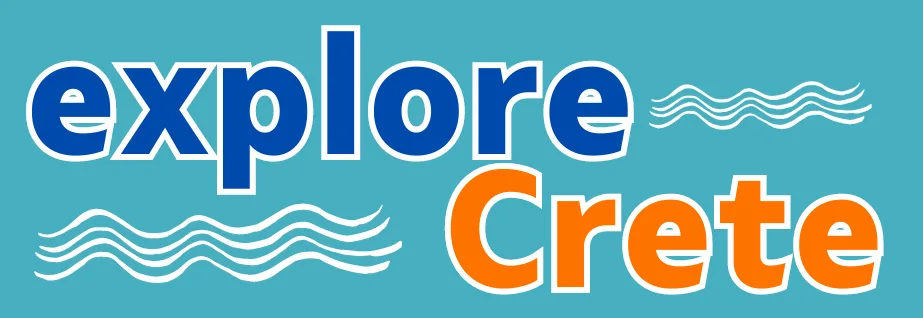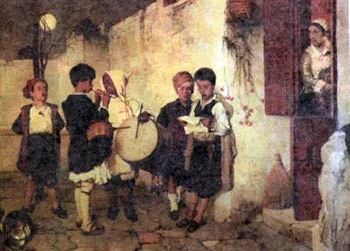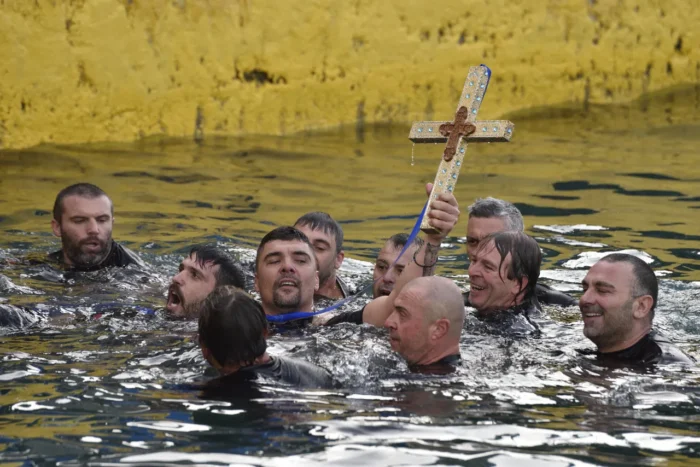Greek Easter in Crete
People who think about visiting Crete often ask: When is the best time to visit Crete? There are many answers to this question, but for people who want a unique experience of the real life in Crete and Greece, I would suggest them to choose the week of the Greek Orthodox Easter.

Table of Contents
Easter, the most important religious holiday in Greece
Easter is the most important holiday of the year for the people of Greece. Easter is always in Spring and nature is most beautiful at that time. The weather is good, neither cold or too hot and it is perfect time for hiking or traveling around. Perhaps it is not the best time of the year for spending a day at the beach but you will experience the wonderful Greek Easter customs and religious ceremonies.
Easter is Pascha in Greek
In the Orthodox Church the feast of Easter is officially called Pascha, the word which means the Passover. It is the eternal Passover from death to life and from earth to heaven.
Easter (Pascha) begins on the Saturday of Lazarus (the Saturday before Palm Sunday) with children and their teachers being very happy because they will spend two weeks far from school.
The Christian symbolism of Easter was first underlined by the Apostle Paul. When the Christians began to celebrate Easter, they retained some of the features of the Jewish Passover, while at the same time adding others. This can be seen from the paschal lamb and the red eggs.
People gather in church every evening throughout Holy Week, especially on Holy Thursday, Good Friday and on Holy Saturday, the night of the Resurrection.
Holy Thursday is the day for dyeing eggs red. The egg, is a symbol of life, while red is the color of life.
In the evening, after the reading of the 12 Gospel, the girls undertake the decoration of the Bier of Christ (epitaphios) with garlands of flowers, so that in the morning of Good Friday it is ready to receive the image of the body of Christ when He is taken down from the Cross. Flowers of various colours are used but in Crete it is common to use the flowers of the lemon tree.
Good Friday, the Procession of the Bier
Good Friday is a day of mourning. The drama of the death of Christ is followed with great devoutness. The icon of Christ is taken off the cross, wrapped in linen and put it in the Bier (Epitafios) symbolizing the tomb of Christ.
Listen to the hymn “Ai geneai pasai” from the CD “Enati Ora” by Petros Gaitanos. In this sample, Virgin Mary mourns for the death of her Son: “Oh, my sweetest child, oh light of my eyes…”

Late at night the bier is carried through the town or village. A band or choir playing or singing solemn music precedes the procession; they are followed by the cantors, the clergy, women bearing myrrh, the altar boys carrying the liturgical fans, scouts and guides, and the people of the region, who sing the hymns throughout the procession. All along its route, people scatter flowers and perfumes on the epitaphios (bier), holding lighted candles in their hands.
Author’s Note. It is difficult to speak about Easter in Greece without getting emotional. It is even more difficult to speak about the night of Good Friday and keep my emotions out of this text.
There is something special about this night. The air is full of the scent of flowers, it is still but not heavy, there is a melancholic feeling all over but there is also something different. There is a feeling of stillness, emptiness, calmness and the hearts seem to open to accept the Love of Jesus’ sacrifice. This is more likely to experience in a small village but it is obvious also in bigger towns in the more remote and quiet neighborhoods.
If you are in Heraklion on Good Friday night, do not miss the procession of the Epitaphs in the center of the city. The Epitaph (bier) processions from four different churches meet at the central crossroad close to Lions Square. The sweet smell of the rose-water in the streets full of people but empty from cars, the sad rhythmic sound of the drum from the Heraklion band, the men and women in traditional costumes, the bishops and priests together with soldiers and many people with lit candles in their hands compose a unique religious image.
- Greek Easter Pictures from the Epitaph Procession in Heraklion
Watch a video clip of the Procession of the Epitaphs in Heraklion. You can see how crowded the streets of the city centre are:
Good Friday Seafood Dinner
In Crete it is a custom to have a late night dinner with seafood after the procession of the bier. In big towns like Heraklion, reservation is absolutely necessary if you don’t want to drive around desperately looking for an empty table. This special dinner includes all kind of seafood but not fish. The dishes which are served include calamares (squids), octopus, shrimps, egg-fish paste (taramosalata), vine leaves stuffed with rice, beans, beetroot and salads. This is the only day during the 40-days fasting period that precedes the Resurrection, that animal proteins are consumed. This great period of Lent before Easter is called by the Orthodox Church, Tessaracoste (Quadragesimal), which comes from the word forty (the 40 days of “fasting”). However, today less and less people fast during the Easter Lent.
Holy Saturday, the Resurrection
On Holy Saturday evening, the Resurrection mass takes place. One hour before midnight everybody goes to the church, each carrying an unlit candle. The churches are crowded and it is not uncommon for many people to stay outside of the church. The mass can be heard from loudspeakers placed outside of the church.
Later during the mass, all lights in the church will be turned off and then the priest will exit the altar with a candle lit by the Holy Light. The Holy Light is transferred by plane from Jerusalem, where it appears in a miraculous way in the Holy Sepulchre (Tomb of Christ).
The Holy Light is distributed by the priest to all people in and out of the church. If people can get back home without their flame going out it, is said they will have a good year.
A few minutes before midnight everybody together with the priest exits the church and, exactly at midnight, the priest announces the resurrection of Christ (Christos Anesti):
“Christ is risen from the dead, trampling down death by death, and upon those in the tombs bestowing life”.
Listen to a sample of “Christos Anesti” from CD “Enati Ora” by Petros Gaitanos.
At that moment fireworks and crackers go off and the dark night is filled with light and colourful explosions. Families and relatives kiss each other and wish “Hronia Polla”. LINK: Video from the celebration of the Resurrection in Agios Nikolaos
This is the time that Judas is burned. A human-sized doll made of old clothes is burned symbolizing the burning of Judas.
After this, everybody goes home for the traditional mageiritsa soup. If their candles are still burning, they use the smoke of the candle to draw a cross on the doorway. This is for the protection of the house for the coming year.
After the Resurrection of Christ (Anastasi), the Easter Lent is finished and Christians may eat animal products again. Their first dinner includes the mageiritsa soup.
Mageiritsa is a soup served only this night and it is made of the lamb’s internal organs: liver, heart, lungs and intestines with an egg-lemon sauce. (link: a recipe for mageiritsa)
After having the soup, red eggs are cracked. Every member of the family will choose an egg and then try to crack the eggs of the others with his own. At the end, only one egg will remain uncracked and the owner will have good luck.
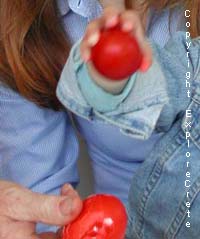
Easter Sunday
On Easter Sunday friends and family gather in homes, eating lamb on the spit, kokoretsi and kalitsounia. Red eggs are cracked again. It is a big feast, sometimes followed by dancing.
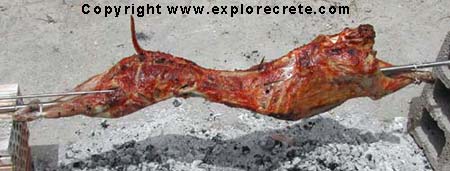
Tips for Easter in Crete:
- The Resurrection is quite spectacular in Hersonissos, where they light big fires on the beach, and especially by the lake of Agios Nikolaos. Thirty minutes before midnight the people of Agios Nikolaos start gathering around the lake of the town and they await for the priests to arrive a few minutes before midnight. At exactly 00:00 a big fire is lit on the lake and hundreds of fireworks explode in the sky of Agios Nikolaos. (link: Greek Easter Pictures)
- The candles, that people carry with them to the church for the Resurrection of Christ, exist in a huge variety of colours and designs. Especially for children they are usually sold together with a toy, which increases their popularity and price. Do not be surprised to see candlesticks with robots for boys or Barbie-dolls for girls.
- No weddings are allowed during the Easter Lent. I don’t think this applies to civil weddings at the City Hall though.
- The lamb of the Easter Sunday is a symbol for the sacrifice of Jesus, who was sacrificed like a lamb for the salvation of people.
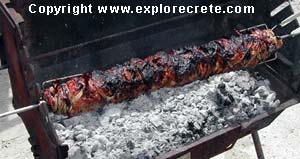
Greek Words for Easter
- Pascha = Easter
- Kalo Pascha = Happy Easter
- Tessarakosti or Sarakosti = Easter Lent
- Nistia = Fasting
- Megali Evdomada = Holy Week
- Megali Pempti = Holy Thursday
- Megali Paraskevi = Good Friday
- Megalo Savato = Holy Saturday
- Anastasi = Resurrection
- Epitaphios = Epitaph, Bier
- Agio Fos = Holy Light
- Papas = Priest
- Ekklisia = Church
- Keri = Candle
- Arni = Lamb
- thalassina = seafood
- htapodi = octopous
- kalamarakia = calamares, squids
- taramosalata = egg-fish salad. It looks like a pink paste.
- dolmadakia = vine leaves stuffed with rice
- pantzaria = beetroots
- fasolia = beans
- salata = salad
- Hronia Polla = It is common to wish this to all your friends for a few days after Resurrection
Dates for Greek Orthodox Easter and Western Easter
2024 – Sunday, May 5
2025 – Sunday, April 20
2026 – Sunday, April 12
2027 – Sunday, May 2
2028 – Sunday, April 16
2029 – Sunday, April 8
2030 – Sunday, April 28
© explorecrete.com All Rights Reserved. Reproduction or copying without permission is prohibited.
